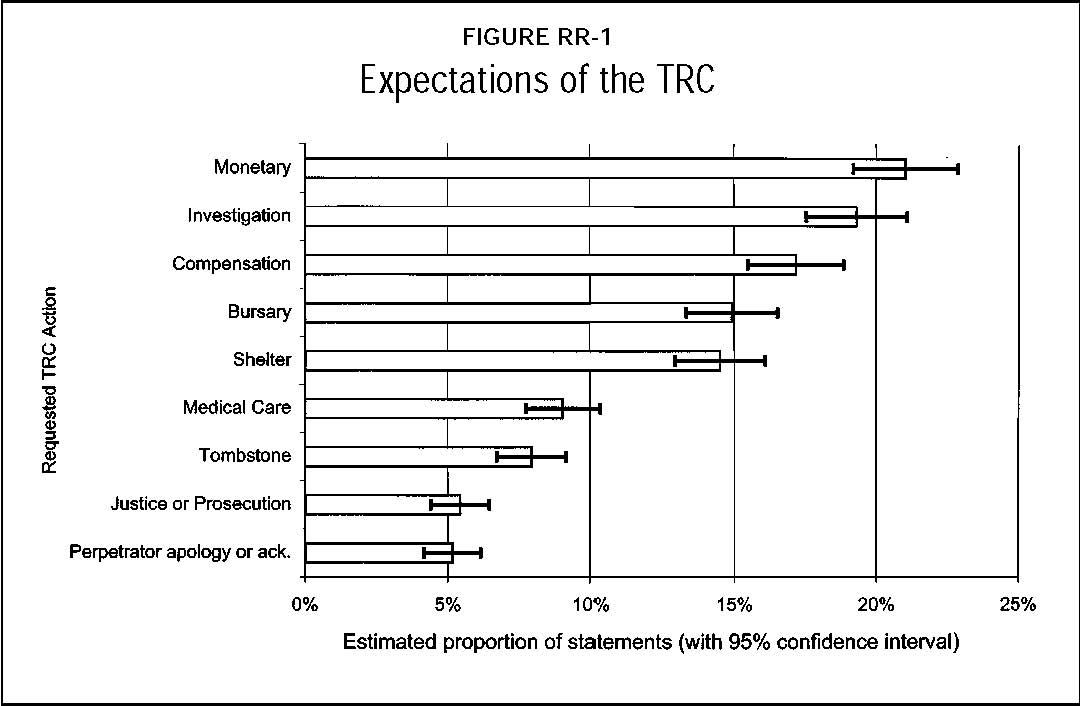 |
News | Sport | TV | Radio | Education | TV Licenses | Contact Us |
 |
News | Sport | TV | Radio | Education | TV Licenses | Contact Us |
TRC Final ReportPage Number (Original) 177 Paragraph Numbers 36 to 45 Volume 5 Chapter 5 Subsection 4 ■ REPARATION AND REHABILITATION POLICY DEVELOPMENT36 In formulating these policies and recommendations, the Reparation and Rehabilitation Committee collected information from a variety of sources. Specifically, the Committee collected information from victims and survivors, representatives of non-governmental organisations (NGOs) and community based organisations (CBOs), faith communities and academic institutions. Consultative workshops were held throughout the country. The information collected from deponents was processed and coded in the Commission database and assisted the Reparation and Rehabilitation Committee to: a establish harm suffered; b determine the needs and expectations of victims; c establish criteria to identify victims in urgent need; d develop proposals regarding long term reparation and rehabilitation measures. 37 The Reparation and Rehabilitation Committee was also guided by internationally accepted approaches to reparation and rehabilitation: a redress: the right to fair and adequate compensation; b restitution: the right to the re-establishment, as far as possible, of the situation that existed prior to the violation; c rehabilitation: the right to the provision of medical and psychological care and fulfilment of significant personal and community needs; d restoration of dignity: the right of the individual/community to a sense of worth; and e reassurance of non-repetition: the strategies for the creation of legislative and administrative measures that contribute to the maintenance of a stable society and the prevention of the re-occurrence of human rights violations. 38 Policy development was also informed by the work and recommendations of other Truth Commissions, in particular the Chilean Commission, which awarded a ‘pension’ to the families of the dead and disappeared; by the decision of the United Nations to award financial compensation to the victims of the Iran-Iraq war; and, most pertinently, by the conclusions of the Skweyiya and Motsuenyane Commissions. 39 The Skweyiya Commission9 recommended that victims of “maltreatment during detention” should receive monetary compensation, appropriate medical and psychological assistance, assistance in completing interrupted education and compensation for property lost. The Motsuenyane Commission10 also recommended compensation to those who suffered human rights violations and assistance with medical expenses. 40 In the process of developing policy, the Reparation and Rehabilitation Committee was faced with a number of decisions. Perhaps the most important of these was whether reparation should be financial and, if so, how much money should be given. 41 The alternative to a financial grant would be a ‘service package’. Offering a service package has a number of pitfalls: a The costs of administering the process might reduce the amount available to victims. b Victims’ needs change over time. Thus, a service package tailored to meet present needs could well be inappropriate after a period. c Dependants’ needs (and status) also change over time. d Giving preferential access to services to select individuals in a community could give rise to tensions. e The way in which a distant implementing body chooses to service a need may not be the way the individual would have chosen him or herself. 42 The Reparation and Rehabilitation Committee decided that a well-structured monetary grant would be preferable to a services package, providing it took two things into account: a It should enable reasonable access to essential basic services. b It should generate opportunities to achieve a dignified standard of living within the South African socio-economic context. 43 A monetary package also gives freedom of choice to the recipient. He or she can use the money in a way that is most appropriate to redress the injustice experienced. Because a monetary package provides government with a set of predictable, limited expenses, it makes fiscal management more feasible. An appropriately organised package requires minimal bureaucratic oversight. 44 The final, and most important factor in favour of an individual monetary grant, was that analysis of a representative sample of statements revealed that most deponents requested reparation in the form of money or services that money can purchase (see Figure RR1). The highest expectation of the reparation process was for monetary assistance. Compensation, bursaries, shelter, medical care and tombstones occupied third to seventh places respectively in the most frequent requests (the second most commonly requested intervention was for investigation of the violation).  45 For all these reasons, it was decided to recommend the provision of urgent interim reparations and individual reparation grants in the form of money. 9 The ‘Report of the Skweyiya Commission of Enquiry into complaints by former African National Congress prisoners and detainees’, August 1992. 10 The ‘Report of the Motsuenyane Commission of Enquiry into certain allegations of cruelty and human rights abuse against ANC prisoners and detainees by ANC members’, August 1993. |